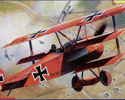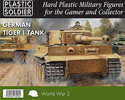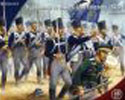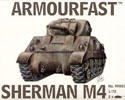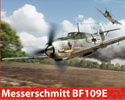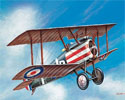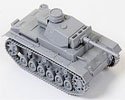The Western Front
On August 1st 1914 Germany declared war on Russia and on the same day German troops entered Luxemburg.
On August 2nd 1914 German troops invaded France declaring war on the French the
day after. On August 4th 1914 German troops invaded Belgium and Britain, obliged
by the Treaty of London to defend Belgian neutrality, issued an ultimatum
demanding that Germans troops withdraw; the ultimatum was ignored and Britain
found itself having to declare war on Germany at midnight that day.
The German Army were executing the Schlieffen Plan, devised to allow
Germany to fight a war on two fronts against France and Russia
simultaneously. The Schlieffen Plan called for a holding force to oppose the
Russian army whilst the majority of German units were deployed in
the West with the intent of knocking France out of the war quickly before
the Russians could fully mobilize.
The Schlieffen Plan was compromised: modifications by von Moltke
the younger, a quicker than expected Russian mobilization and British
troops arriving in Belgium far sooner than thought, who fought much harder, at Mons and Le
Cateau, than anticipated, were all factors that had a negative impact on the
Schlieffen Plan. The German thrust to outflank Paris was parried and
between September 6th and 10th at the Battle of the Marne the Entente forces
held the German armies forcing them to retire north to a defensive position
behind the Aisne. There followed the 'Race to the Sea' all the way to the
channel coast, during which the opposing armies tried to outflank each
other. This was to become the essence of the network of trenches stretching
over 500 miles from the Swiss border to the Channel coast that was known as
the 'Western Front'.
The Battle of Mons, August 1914.
On August 23rd 1914, the Battle of Mons was the first
confrontation between the British Expeditionary Force and the German Army.
The B.E.F. assumed a holding position along the line of the canal that runs
through the town of Mons to give the French First Army, on its right flank,
time to withdraw. The British infantry were trained to deliver rapid aimed
rifle fire and took a dreadful toll of the advancing close order German
infantry units. The B.E.F. had no choice but to retire and fell back in
reasonably good order towards Le Cateau.
The Battle of Le Cateau, August 1914.
The exhausted IInd Corps of the retiring B.E.F. gathered at the
village of Le Cateau on the night of August 25th 1914. Smith-Dorrien, the Corps commander,
appraised his situation and felt he had no choice but to turn and fight the
following German vanguard. The action was similar to Mons but with a more
significant part being played by artillery. Losses were high on both sides
but IInd Corps BEF was able to slip away in the evening and continue its
retreat. The German pursuit was hesitant and cautious; the action at Le
Cateau slowing down the
German advance and playing a decisive part in preventing the German attack
on Paris from developing as planned.
The First Battle of the Marne, September 1914.
The French and British forces fell back before the
advancing German armies to a position on the south bank of the Marne.
Instead of continuing as planned and encircling Paris the German First Army
turned east to attack the exhausted British and French forces along the
Marne. On September 6th 1914, the French Sixth Army attacked the German
First Army in the flank forcing them to turn west and create a gap between
the German First Army and Second Army. The BEF was launched at the gap
whilst the French Fifth Army pinned the German Second Army. Six thousand
French reserves were ferried from Paris to the front 30 miles away in order
to allow the French Sixth Army to maintain pressure on the German First
Army. An aggressive attack by the French First Army convinced von Moltke
that a breakthrough by the Entente forces was imminent and, on August 9th,
he ordered a retreat back to a line along the River Aisne.
First Battle of the Aisne, September 1914.
After their victory at the Battle of the Marne, the Entente was slow to pursue the retreating Germans and
gave them the opportunity to prepare a defensive line along the high ground
to the North of the Aisne. On September 13th 1914 the allies opened a
frontal attack on the German positions, creating a bridgehead north of the
river on September 14th. It soon became apparent that a frontal attack was
out of the question after several attempts had been repulsed by entrenched German troops
using machine guns and artillery fire. By September 28th hopes of a frontal
attack by the Entente succeeding had been abandoned and both sides moved west towards the
Channel coast in an effort to outflank each other.
The Race to the Sea
With the stalemate at the Aisne both sides moved West, each
side attempting to outflank the other. The First Battle of Albert, between
September 25th and 28th, the Battle of Arras around October 1st were
inconclusive and the armies continued north towards Flanders.
First Battle of Ypres, October 1914
On October 20th 1914, an offensive was launched by the new
German commander, Erich von Falkenhayn against the Belgian town of Ypres.
The north side of the town was defended by the BEF with the French covering
the flank. The offensive stalled when Belgian troops flooded the area
between them and the Germans. The German attacks recommenced on
October 31st and continued until 22nd November 1914, when winter weather
forced the combatants to break off. The First Battle of Ypres witnessed the
deployment of the first British Commonwealth troops in the form of the Indian Corps,
who were to prove to be a very valuable asset.
The Battle of Neuve Chapelle, March 1915
The Battle of Neuve Chapelle was intended by Sir John
French, the British commander, to be a limited attack on the village of
Aubers and put pressure on the German defenses around Lille. In doing this
this he intended to reduce the German salient around Neuve Chappelle. On the
morning of March 10th 1915 the British First Army, under the orders of Sir
Douglas Haig, opened up a barrage, directed by reconnaissance aircraft of
the Royal Flying Corps, that was intended to soften up the German defenses. Thirty
Five minutes later 40,000 men moved out of the trenches and attacked the
German line. Neuve Chappelle was taken after four hours of hand-to-hand
fighting, but the British found it impossible to exploit the success by
attacking the German lines that had not been softened up with artillery
around Aubers. The battle of Neuve Chapelle was the first to set the scene for
future battles; set piece attacks on ground prepared by heavy artillery
bombardment.
Second Battle of Ypres, April 1915
The primary concerns for the German Army during 1915 were
the actions on the Eastern Front against the Russians. The German attack on Ypres
in 1915 was mainly to test the use of gas. On April 22nd 1915 one hundred and sixty eight tons of
chlorine gas was released against the French positions over a front of 6.5
km. The Allied troops retreated in panic, over 5,000 of
them being killed by the greenish-yellow gas. The German infantry advanced
relatively un-opposed into the vacant trenches but no one had anticipated how
easily and there was no reinforcements available to achieve a
breakthrough. A second gas attack was made against Canadian positions on
April 24th. This attack was met with more resistance and the Germans
suffered relatively heavy casualties. On May 1st the British executed a 4km withdrawal toward Ypres
and a more easily defendable line. More gas
attacks continued until the end of May, when a lack of manpower and
resources forced the Germans to call off the attacks. The allied armies had
lost nearly 70,000 men, a significant portion of which being due to the gas. The
Germans had lost around 35,000 men and had gained a small amount of high
ground to the East of Ypres. The Allies were quick to develop their own gas
after the successful deployment of it by the Germans.
Verdun, February 1916
On Christmas Day 1915 the German Chief of Staff, Erich von
Falkenhayn, wrote a letter to the Kaiser, Wilhelm II. The letter identified
Britain as the cornerstone of the Anglo-French Russian alliance and
outlined a plan to force Britain out of the war by the application of
unrestricted submarine warfare, whilst an offensive on land was intended to
'bleed France dry' of manpower. This re-directed the effort from the eastern
Front to the Western Front, a move criticized heavily by Paul von
Hindenburg the Eastern Front commander. Verdun was chosen as the target for
von Falkenhayn's land offensive and on February 20th 1916 was subjected to a huge
artillery bombardment, followed by infantry attacks on the 21st. German
strategy revolved around forcing the French to make counter attacks that
exposed them to German artillery fire. The offensive lasted until December
18th 1916 and cost around one million casualties suffered equally between
both sides. In terms of success the Verdun offensive failed miserably to
'bleed' the French Army to death and it cost von Falkenhayn his job; Paul von Hindenburg
replacing him on August
29th.
Battle of the Somme, July 1916
A joint offensive between the British and the French had
been planned for August 1916. The offensive had been intended as a
battle of attrition rather than a means to capture ground. Von Falkenhayn's
Verdun offensive had focused French attention onto the defense of that
fortress. The French had pleaded with the British to bring the planned
offensive forward to relieve the pressure on the defenders at Verdun. The
area of the Somme had been chosen for the joint offensive simply because it was
the junction of the French and British lines. With the French firmly fixed
on Verdun the Somme Offensive became primarily a British undertaking that
now sought to create a breakthrough in the German line. On 24th June 1916 a
preliminary bombardment by around 3,000 guns commenced that was to last eight
days. It was expected to destroy the German defenses and leave a gap that
could simply be occupied by the British troops. The British offensive began
on the morning of July 1st with the explosion of 17 mines. A creeping
barrage preceded the lines of infantry but the initial bombardment had
failed to destroy the barbed wire and gun emplacements. As the barrage
passed the German Infantry came out from their protective bunkers and put up a
fierce resistance, forcing the British back to their start point having
suffered 58,000 casualties, a third of which were fatal. Sir Douglas Haig, the British
commander, was convinced that the German Army was exhausted and persisted
with the
attacks despite mounting heavy casualties. In September tanks were used for
the first time but these new weapons added little of value to the attack.
The Offensive continued to November 18th when poor weather forced a halt to
the fighting. Allied losses totaled a staggering 620,000 men, German losses were not
quite as high but still came to around 500,000 men.
Battle of Vimy Ridge, April 1917
Vimy Ridge was a portion of high ground occupied by German
forces that overlooked the Allied held town of Arras. The ridge was a
honeycomb of formidable defenses that the Germans had been using as a
platform to bombard
Arras to great effect since 1914. Several French and British attempts to
take the ridge had failed incurring large casualties. At first light on April 9th
1917, following an artillery barrage that had lasted three weeks, Canadian
troops attacked the ridge. Within the hour the front and second line of
German trenches were captured and by April 12th the entire ridge had been
occupied by the Canadian troops. The Canadians had suffered over 10,000
casualties and the Germans 20,000. Nevertheless the operation was considered
a great success.
Second Battle of the Aisne, April 1917
In 1916 the French commander, Robert Nivelle envisaged a
breakthrough offensive across the Aisne, expecting it to end the war in a
matter of says. The offensive began on April 16th 1917 and, far from ending
the war, nearly ended in disaster for the French Army. The Offensive saw the
use of tanks by the French army but they provided little assistance to the
infantry. The offensive was called off on May 9th after repeated failed
assaults that cost the French over 187,000 casualties, whilst inflicting
around 168,000 casualties on the German Army. Nivelle was dismissed for the
failure of the offensive, being replaced by Henri-Philippe Petain.
Battle of Passchendaele, July 1917
Sir Douglas Haig, the British commander, had entertained
hopes of an offensive into Flanders during 1916. The battle of Verdun had
necessitated that the British undertake the Somme offensive in an effort to
relive the French, forcing Haig to postpone his ambitions in Flanders.
During June the British 2nd Army had successfully taken Messines Ridge and
Passchendaele ridge was proposed as an immediate follow up. The Battle of
Passchendaele, sometimes referred to as the Third Battle of Ypres, began on
July 31st 1917 after 10 days of preliminary artillery bombardment. Heavy
rains, that flooded the churned up battlefield into a mud bath, hindered
allied mobility and few gains of any significance were made. By November
6th, when the offensive was called off, for a territorial gain of only a few
miles the allies had suffered over 300,000 casualties, the Germans over
250,000. The battle was notable for the first German use of mustard gas.
Battle of Cambrai, November 1917
The Battle of Cambrai was notable for the first massed use
of tanks during the First World War. The attack began on November 20 1917,
when 476 tanks supported by six infantry divisions went 'over the top'
without the usual preliminary artillery bombardment. The Germans were taken
by surprise and huge territorial gains were made by the British. The
British, however, were not prepared for the success and weren't in a
position to exploit it. German counter-attacks forced the British back and
by around November 27 had reclaimed most of the lost ground. Losses amounted
to around 45,000 British and 50,000 Germans.
Third Battle of the Aisne, May 1918
The Third Battle of the Aisne was conducted by Erich
Ludendorff as a diversionary attack intended to divert troops from Flanders
before striking a major blow there. It began on May 27th with an intense
bombardment, supported by gas, of the Chemin des Dames Ridge, then
held by four recuperating divisions of the British IX Corps. The British
divisions were annihilated by the surprise attack and could not oppose the
17 divisions of German infantry that advanced against them. By the end of
the first day the Germans had advanced 15km and by May 30th they were within
90km of Paris. By June 6th the German advance had ground to a halt through
lack of supplies and fatigue. The Allies had suffered nearly 130,000
casualties, at least 50,000 being taken prisoner.
Second Battle of the Marne, July 1918
On July 15th 1918, Erich Ludendorff the effective German
Supreme Commander, launched the last attempt at winning the war for Germany.
The attack was made as two spearheads, one to the east of Rheims and one to the
west. The attack to the east was halted on the first day after making no
progress. The attack to the west made more progress and succeeded in
establishing a bridgehead across the Marne, but even this was halted on July
17th by a combined force of French, British and American troops. The Allied
Supreme commander, Ferdinand Foch, immediately ordered a counter attack that
drove the Germans back to their start line by August 3rd. The German losses
were high at 68,000, as were the allies at 120,000. The Battle marked the
end of the German offensive operations in the west.
